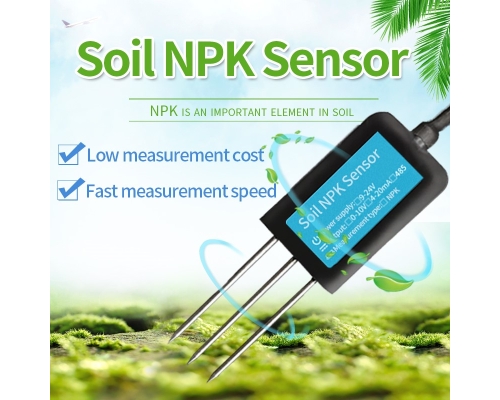In the ever-evolving landscape of modern agriculture, technology has become an indispensable tool for farmers seeking to optimize crop yields, minimize resource use, and protect the environment. Among the myriad of technological advancements, smart soil sensors are emerging as a cornerstone of precision farming, heralding a new era where data-driven decisions lead to more sustainable and profitable agricultural practices. This article delves into the world of smart soil sensors, exploring their capabilities, benefits, and the transformative impact they are poised to have on the future of farming.

The Rise of Precision Farming
Precision farming, also known as smart farming or site-specific crop management, leverages advanced technologies such as GPS, drones, robotics, and, importantly, soil sensors to gather detailed information about field conditions. This data-rich environment allows farmers to tailor their farming practices to specific areas within their fields, addressing variations in soil type, moisture levels, nutrient availability, and other critical factors. By making informed decisions based on real-time data, farmers can enhance productivity, reduce input costs, and minimize environmental footprint.
Smart Soil Sensors: The Heartbeat of Precision Farming
Smart soil sensors are at the core of this precision revolution. These devices, embedded within the soil or mounted on agricultural equipment, continuously monitor a range of soil parameters including moisture content, temperature, pH levels, electrical conductivity (a proxy for salinity), and nutrient concentrations. Equipped with state-of-the-art microelectronics and wireless communication capabilities, these sensors transmit real-time data to a central platform, where farmers can access and analyze it via user-friendly interfaces.
Moisture Management: The Key to Efficient Irrigation
One of the most critical functions of smart soil sensors is precise moisture monitoring. Excessive or insufficient water can drastically affect crop health and yield. By measuring soil moisture at various depths, farmers can implement targeted irrigation strategies, ensuring plants receive the exact amount of water they need, when they need it. This not only conserves precious water resources but also reduces energy consumption associated with pumping and distribution.
Nutrient Monitoring: Optimizing Fertilizer Use
Smart soil sensors also play a pivotal role in nutrient management. By continuously monitoring soil nutrient levels, farmers can apply fertilizers more precisely, avoiding over-application which leads to nutrient runoff and pollution. Targeted fertilization not only reduces costs but also enhances soil health and crop quality. Additionally, sensors can detect deficiencies early, allowing for timely interventions that maintain plant health and maximize productivity.
pH and Salinity Balance: Maintaining Optimal Soil Conditions
Soil pH and salinity are crucial factors influencing nutrient availability and plant growth. Smart sensors enable farmers to monitor these parameters closely, enabling adjustments to lime or gypsum applications to maintain optimal pH levels and manage salinity issues. Proper pH balance is essential for nutrient uptake, while controlling salinity helps prevent plant stress and soil degradation.
The Benefits of Smart Soil Sensors
The integration of smart soil sensors into precision farming systems offers a multitude of benefits:
- Increased Productivity: By providing accurate, real-time data, sensors enable farmers to make timely and informed decisions that maximize crop yields and quality.
- Cost Savings: Precision application of water and fertilizers reduces waste and input costs, translating into significant economic savings.
- Environmental Sustainability: Targeted resource use minimizes pollution from runoff and leaching, preserving natural ecosystems and promoting sustainable agriculture.
- Risk Mitigation: Early detection of soil problems, such as nutrient deficiencies or excessive moisture, allows for prompt corrective actions, reducing the risk of crop failures.
- Enhanced Decision-Making: Access to comprehensive soil data empowers farmers to adopt more scientific and evidence-based farming practices.
Challenges and Opportunities
Despite their numerous advantages, the adoption of smart soil sensors faces some challenges. Initial investment costs can be prohibitive for small-scale farmers, while technical expertise required for installation and maintenance may pose barriers. Furthermore, data privacy and security concerns need to be addressed to ensure farmers’ information remains protected.
However, these challenges are being addressed through government subsidies, collaborative research initiatives, and the development of user-friendly, cost-effective sensor systems. Innovations in sensor technology, such as the integration of artificial intelligence and machine learning algorithms, are enhancing data analysis capabilities, making interpretation more accurate and actionable.
The Future of Smart Farming
Looking ahead, the future of smart farming is bright. As sensor technology continues to evolve, we can expect even more sophisticated devices capable of measuring a broader spectrum of soil parameters with higher precision. The convergence of IoT, big data, and AI will further empower farmers with predictive analytics, enabling them to anticipate and address potential issues before they impact crop performance.
Moreover, the development of integrated farming management systems that seamlessly integrate data from multiple sources—including soil sensors, drones, weather stations, and satellite imagery—will provide farmers with a holistic view of their operations. This comprehensive data set will facilitate more strategic planning, enhancing overall farm efficiency and profitability.
Conclusion
Smart soil sensors are the linchpin of precision farming, driving a paradigm shift towards more data-driven, sustainable, and profitable agricultural practices. By providing farmers with real-time insights into soil conditions, these devices enable them to make informed decisions that optimize resource use, enhance crop yields, and protect the environment. As technology advances and adoption barriers diminish, smart soil sensors will increasingly become indispensable tools in the toolkit of modern farmers, shaping the future of agriculture for generations to come.
In summary, the integration of smart soil sensors marks a significant step forward in the journey towards precision farming. It represents a commitment to leveraging technology to address the complex challenges of feeding a growing global population while preserving our planet’s precious resources. As we continue to innovate and adapt, the promise of smart farming becomes ever more tangible, heralding a new era of agricultural excellence.